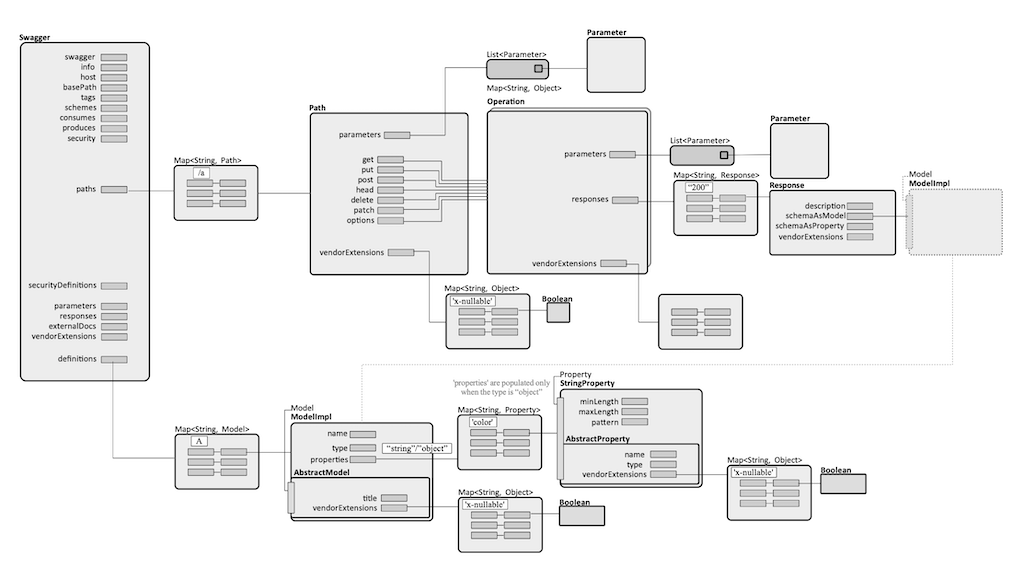OpenAPI Specification
Internal
Overview
The document addresses both OpenAPI 2.0 and OpenAPI 3.0. The differences will be emphasized.
Swagger Java Model
info
title
When imported in AWS API Gateway, the title provides the API name.
paths
Contains a map of paths.
Path
The path is designated by its literal, as key in the paths map. Each path contains zero or one of these operations: GET, POST, PUT, HEAD, DELETE, PATCH, OPTIONS, a list of Parameters and a map of vendor extensions.
Operation
paths:
/a:
get:
parameters:
- name: 'test'
in: query
type: 'string'
responses:
200:
schema:
$ref: '#/definitions/Empty'
definitions:
Empty:
type: object
Also see:
Valid operation keys:
- get
- put
- post
- delete
- options
- head
- patch
parameters
Contains a list of in-line declaration of parameters (parameter objects) and references.
responses
A required element that list all possible responses that are returned from executing this operations. The element must contain at least one response code. The container maps a HTTP response code to the expected response. The definition is not expected to cover all possible HTTP response codes, because they may not be known in advance. However, the definition should cover a successful operation response and any known errors. The "default" map key may be used as a default response object for all HTTP codes that are not covered individually in the definition.
paths:
/a:
get:
responses:
200:
...
default:
...
produces
Contains a list of media types this operation can respond with. The list specified at operation level overrides the list specified on global level. Document that.
paths:
/a:
get:
produces:
- application/json
Note that Swagger Core Operation.getProduces() may return null.
consumes
Note that Swagger Core Operation.getConsumes() may return null.
tags
Each API operation can be annotated with a list of tags. Tagged operations may be handled differently by tools and libraries. Optionally, each tag can get a "description" and an "externalDocs" in the global "tags" section on the root level. The tag names here should match those used in operations. The tag order in the global tags section also controls the default sorting in the UI - at least, for Swagger UI. It is possible to use a tag at operation level even if it is not specified on the root level.
tags:
-name: tag-a
description: Something that would shed light on tag-a semantics
externalDocs:
url: http://example.com/my-docs/tag-a.html
paths:
/a:
get:
tags:
- tag-a
- other-tag
Parameter
There are five parameter types: path, query, request header, request body and form parameters.
Path Parameter
Query Parameter
Request Header
Request Body
Form
Response
A response is defined by its HTTP status code and the data returned in the response body and/or headers.
200:
description: 200 response
schema:
$ref: '#/definitions/Empty'
originalRef: '#/definitions/Empty'
headers:
Access-Control-Allow-Origin:
type: 'string'
Access-Control-Allow-Methods:
type: 'string'
Access-Control-Allow-Headers:
type: 'string'
description
The description is required. Represents a short description of the response.
Response Body
schema
The schema keyword is used to describe the response body. A schema defines an object or array – typically used with JSON and XML APIs, a primitive such as a number or string – used for plain text responses, or a file. The schema can be defined in-line or defined at the root level of the document and referenced via $ref. This is useful if multiple responses share the same schema.
In-line schema:
responses:
200:
description: something
schema:
type: object
properties:
id:
type: integer
description: The user ID.
username:
type: string
description: The user name.
This is an example that uses references:
responses:
200:
description: something
schema:
$ref: '#/definitions/User'
...
definitions:
User:
type: object
properties:
id:
type: integer
description: The user ID.
username:
type: string
description: The user name.
"responseSchema" is sometimes used, but that seems to be deprecated.
Empty Response Body
For responses that have no body, like 204 No Content, no "schema" should be specified. This is conventionally treated as no-body response.
Response Headers
Responses can include custom headers, or headers that implement a protocol like CORS.
headers
The custom headers must be declared, under the "headers" section of the response. For OpenAPI 2.0, there is no way in Swagger to define common response headers for different response codes or different API operations. You need to define the headers for each response individually. "headers" is aA container that maps a header name to its definition. The header names are case insensitive. If a header is specified by the an extension, such as x-amazon-apigateway-integration, it has to be declared in the headers section for the corresponding response, otherwise a template error is generated.
200:
description: 200 response
...
headers:
Access-Control-Allow-Origin:
type: 'string'
Access-Control-Allow-Methods:
type: 'string'
Access-Control-Allow-Headers:
type: 'string'
schema:
$ref: '#/definitions/Empty'
originalRef: '#/definitions/Empty'
Reference Object
$ref
CORS
More:
Organizatorium
x-nullable
Appears in automatically generated Swagger files, as such:
definitions:
LibraryAccount:
type: object
required:
- name
properties:
name:
type: string
x-nullable: true
definitions:
A:
type: string
title: A
x-nullable: true
When used for an API Gateway import, it errors out as:
Unable to create model for 'LibraryAccount': Invalid model specified: Validation Result: warnings : [], errors : [Invalid model schema specified. Unsupported keyword(s): ["x-nullable"]]
